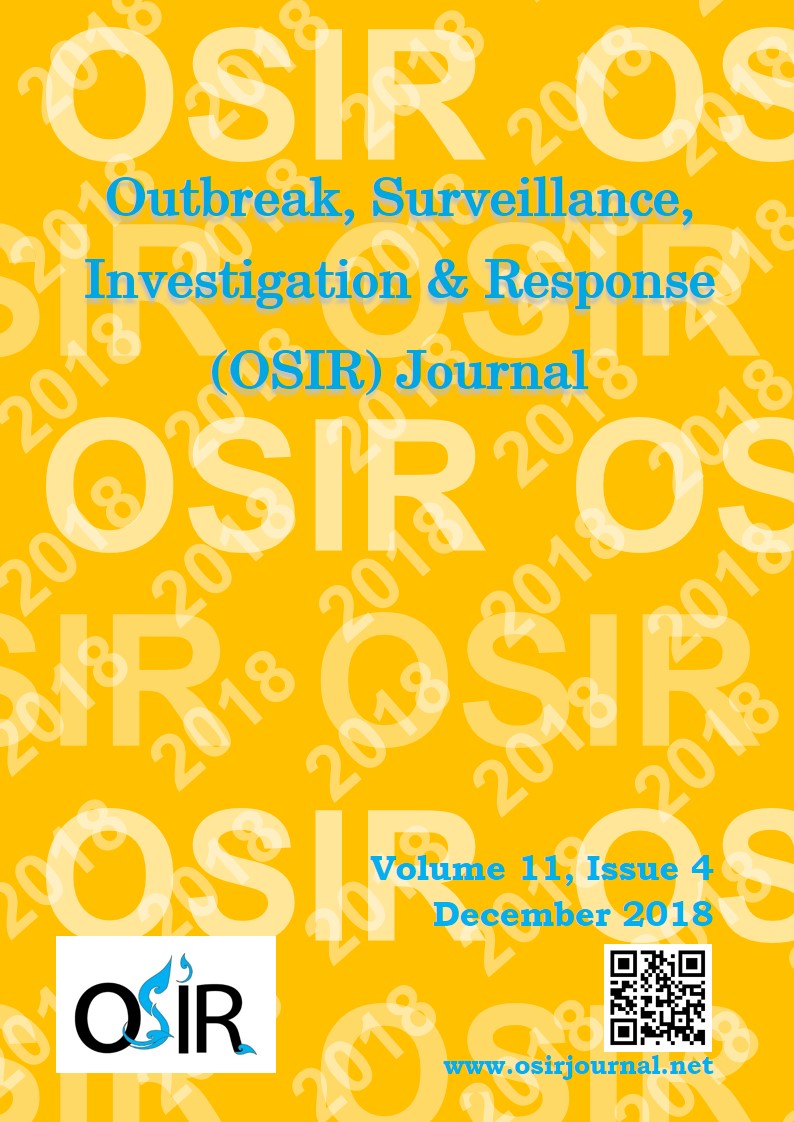Situation of Malaria and Expansion of Key Interventions for Malaria Elimination in Bago Region, Myanmar, 2007-2015
DOI:
https://doi.org/10.59096/osir.v11i4.263049Keywords:
malaria situation, annual blood examination rate, annual parasite incidence, MyanmarAbstract
Analysis of malaria trends is important for planning of malaria elimination. Therefore, we reviewed the malaria monthly reports and key interventions for malaria elimination in Bago Region of Myanmar between 2007 and 2015. Secondary data analysis revealed the trends in malaria morbidity, mortality, malaria positive rate (MPR), malaria species, annual parasite incidence (API) and annual blood examination rate (ABER). Key interventions included distribution of insecticide-treated net (ITN), long lasting insecticidal net (LLIN) and case detection. Over the 8-year period, malaria morbidity and mortality rates markedly reduced from 8 to 0.3 per 1,000 population and 1.4 to 0.1 per 100,000 population respectively. During 2010-2015, API and MPR correspondingly reduced. Together with the concomitant increase in ABER and townships with API lower than one per 1,000 population, confirmed cases of P. falciparum malaria markedly decreased from 91.1% in 2007 to 55.4% in 2015. Meanwhile, the ITN/LLIN scaling-up activities resulted in an increase in population coverage from 23.5% in 2011 to 69.3% in 2015. Data from the public sector showed declining trends in malaria morbidity and mortality and low API, increasing the chance of malaria elimination. Still, there is a possibility of residual malaria that may trigger a resurgence, and thus, it is worthwhile to promote surveillance systems, especially in private sector health care establishments.
References
World Health Organization. World malaria report 2015. Geneva: World Health Organization; 2015.
World Health Organization. Country profile on malaria, Myanmar. 2017 [cited 2016 Jul 15]. <http://www.who.int/malaria/publications/country-profiles/profile_mmr_en.pdf>
Myanmar. Vector Borne Disease Control and National Malaria Control Programme. Department of Health. Ministry of Health. Annual VBDC report 2015. Nay Pyi Taw: Ministry of Health, Myanmar; 2015.
World Health Organization. Strategy for malaria elimination in the Greater Mekong Sub-region (2015-2030). Geneva: World Health Organization; 2015 [cited 2016 Jul 15]. <http://.www.wpro.who.int/entity/mvp/documents/strat_mal_elim_gms/en>
Myanmar. Vector Borne Diseases Control Programme. Bago Regional Public Health Department. Ministry of Health. Annual VBDC reports, 2007-2015. Bago: Bago Regional Public Health Department; 2016.
Myanmar. Bago Regional Public Health Department. Ministry of Health. Annual health statistic report 2015. Bago: Bago Regional Public Health Department; 2016. Myanmar.
World Health Organization. Framework for malaria elimination. Geneva: World Health Organization; 2017.
Myanmar. Ministry of Health. Monitoring - evaluation plan malaria prevention and control, 2010-2015. Nay Pyi Taw: Ministry of Health, Myanmar; 2012.
Myanmar. Ministry of Health. Monitoring and evaluation plan, 2016-2020. Nay Pyi Taw: Ministry of Health, Myanmar; 2017.
Khine SK, Swaddiwudhipong W, Lwin NN, Timasarn K, Hlaing T. Epidemiological situation of malaria in Rakhine State, Myanmar during 2000-2014. OSIR. 2017 Sep;10(3):16-21.
World Health Organization. Policy brief on malaria diagnosis in low transmission settings. Geneva: World Health Organization; 2014.
Landier J, Parker DM, Thu AM, Carrara VI, Lwin KM, Bonnington CA, et al. The role of early detection and treatment in malaria elimination. Malar J. 2016 Jul 15;15:363.
Roy S, Khatun T. Analysis of trend of malaria prevalence in the ten Asian countries from 2006 to 2011: a longitudinal study. Malaria Research and Treatment. 2015;4:1-7.
Tesfa H, Bayih AG, Zeleke AJ. A 17-year trend analysis of malaria at Adi Arkay, north Gondar zone, Northwest Ethiopia. Malar J. 2018 Apr 6;17(1):155.
Wongsrichanalai C, Barcus MJ, Muth S, Sutamihardja A, Wernsdorfer WH. A review of malaria diagnosis tool: microscopy and rapid diagnostic test (RDT). Am J Trop Med Hyg. 2007 Dec;77(6 Suppl):119-27.
Durrhein DN, Becker PJ, Billinghurst K, Brink A. Diagnostic disagreement – the lessons learnt from malaria diagnosis in Mpumalanga. S Afr Med J. 1997;87:609-11.
Maguire JD, Lederman ER, Barcus MJ, O'Meara WA, Jordon RG, Duong S, et al. Production and validation of durable, high quality standardized malaria microscopy slides for teaching, testing and quality assurance during an era of declining diagnostic proficiency. Malar J. 2006 Oct 25;5:92.
Nwe TW, Oo T, Wai KT, Zhou S, van Griensven J, Chinnakali P, et al. Malaria profiles and challenges in artemisinin resistance containment in Myanmar. Infect Dis Poverty. 2017 Apr 25;6(1):76.
Kyaw AMM, Kathirvel S, Das M, Thapa B, Linn NYY, Muang TM, et al. “Alert-Audit-Act”: assessment of surveillance and response strategy for malaria elimination in three low-endemic settings of Myanmar in 2016. Tropical Medicine and Health. 2018;46:11.
Maung TM, Oo T, Wai KT, Hlaing T, Owiti P, Kumar B, et al. Assessment of household ownership of bed nets in areas with and without artemisinin resistance containment measures in Myanmar. Infect Dis Poverty. 2018 Mar 23;7(1):19.
Downloads
Published
How to Cite
Issue
Section
License
Copyright (c) 2023 Outbreak, Surveillance, Investigation & Response (OSIR) Journal

This work is licensed under a Creative Commons Attribution-NonCommercial-NoDerivatives 4.0 International License.









